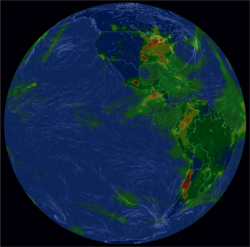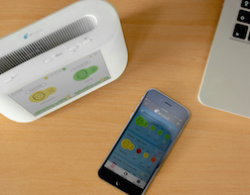Out of Sight, Out Of Mind: Visualizing the Invisible
Posted on Categories Discover Magazine

By Kaitlin Vortherms
When smog is so thick that it clouds our vision, we can see and acknowledge that air pollution is a problem. In December of last year, China issued its second ever red alert, their highest rating for air pollution, and last month, London broke modern air pollution records.
But on days when the haze has lifted, we tend to forget air pollution is still there. More to the point, we forget about how air pollution affects our health and the environment. It’s out of sight, and therefore, out of mind.
But what if we could actually see air pollution levels, even when the smog isn’t present? Would this motivate us to make changes about how we live our lives? This is where AirVisual comes in. Air Visual is a crowd-sourced platform that provides information and access to historical, real-time, and forecast air quality data in a visually engaging way.
Yann Boquillod, AirVisual’s project lead, started the project a year and a half ago with the goal of bringing awareness to the issue of air pollution.
Screen shot of air quality on February 21, 2017 from AirVisual. Credit: https://airvisual.com/earth
“The idea,” he says, “was to visualize, to empower people with data.” And this is just what the AirVisual team has done.
Boquillod’s curiousiy about air pollution levels in his own home—and what his children might be exposed to—is what motivated him to develop AirVisual. In addition to its free data and online tools, AirVisual also has developed an air quality monitor called the node, which provides recommendations for action according to the air quality data it provides.
While their team is international, their headquarters is in Beijing, China. Boquillod says this is the best place to study air pollution. “We are really using China as the base of innovation for the rest of the world.”
Through their outreach efforts, AirVisual informs people about air pollution by using the node to do a free air quality assessment of people’s homes in Beijing. They volunteer their time by going to people’s homes to do a demo of the node and provide them advice on how to upgrade the air quality of their air.
Many people are not aware that if they are not using air purifiers and secured windows, that the air pollution outdoors is more or less the same indoors. It’s information like this—not only air quality assessment, but also advice and guidance on ways to improve indoor air quality—that AirVisual provides.
Boquillod uses this device in his own home to monitor levels of PM2.5, tiny particles that damage the throat and lungs, CO2 levels, temperature, and humidity, to monitor air quality and make necessary changes to his air filters or indoor environment accordingly.

AirVisual node and application shown on a smartphone. Photo: AirVisual
Of course, air pollution is a global problem. That’s why Air Visual joined the SciStarter community: to educate and engage people internationally. Boquillod aims to provide access to their data and air-monitoring device for individuals, organizations, schools and universities interested in monitoring air quality around the world. He hopes to grow awareness of air pollution through platforms like SciStarter and looks forward to learning more about global air quality from data collected around the world.
To join the project, participants purchase the node, which is available for $199 from their website and run the air quality monitor throughout the day. Users can then download the device’s historical data, and submit findings to Air Visual.
Participants also may join a growing network of public air quality data sources, providing valuable data to researchers and policy makers. In addition, the Air Visual node is one of the most affordable and comprehensive air quality monitors in the market, making it easy for you to be aware of invisible pollution threats inside and outside your home.
Ultimately, Air Visual wants to use its data to help people see, understand, and make change in their local communities to combat the health and environmental issues presented by air pollution. Check out their SciStarter project page to get started!
Kaitlin is a sustainable engineer with a passion for empathy driven design. She recognizes the need for STEM fields to communicate their messages more effectively in order to enhance community engagement and a build a better world.
Want more citizen science? Check out SciStarter’s Project Finder! With 1100+ citizen science projects spanning every field of research, task and age group, there’s something for everyone!